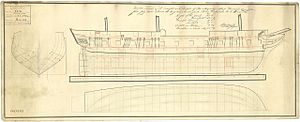HMS Princess Charlotte (1814) facts for kids

Drawing showing the body plan, sheer lines with inboard detail, and longitudinal half-breadth for Princess Charlotte, 1815
|
|
Quick facts for kids History |
|
|---|---|
| Name | Princess Charlotte |
| Ordered | 1813 |
| Builder | Kingston Royal Naval Dockyard, Kingston |
| Launched | 14 April 1814 |
| Commissioned | 5 May 1814 |
| Renamed |
|
| Fate |
|
| General characteristics | |
| Type | 42-gun fifth-rate frigate |
| Tons burthen | 755 90⁄94 bm |
| Length |
|
| Beam | 37 ft 8 in (11.5 m) |
| Draught | 14 ft 4 in (4.4 m) |
| Depth of hold | 8 ft 8+1⁄2 in (2.7 m) |
| Complement | 280 |
| Armament |
|
HMS Princess Charlotte, later known as HMS Burlington, was a powerful warship built in 1814. This 42-gun frigate was part of the Royal Navy. She was built during the War of 1812 at the Kingston Royal Naval Dockyard in Kingston, Ontario, Canada.
The ship was first named Vittoria but was renamed Princess Charlotte before she was even launched. She was designed by George Record and built by John Goudie. The Princess Charlotte served on Lake Ontario and was officially ready for duty on May 5, 1814. Captain William Mulcaster was her first commander.
The Princess Charlotte played a role in the British attack on Fort Oswego and helped blockade, or block off, Sackett's Harbor in 1814. In December 1814, her name was changed again to HMS Burlington. The ship was put up for sale in 1833 but found no buyers. Later, she was intentionally sunk, a process called scuttling.
Contents
About the Princess Charlotte
The Princess Charlotte was designed by George Record. He worked at the Kingston Royal Naval Dockyard in Kingston, Ontario. This frigate was built by John Goudie.
Ship Size and Features
The ship was about 755 tons burthen, which is a way to measure a ship's carrying capacity. She was about 121 ft 0 in (36.9 m) long from front to back. Her width, or beam, was about 37 ft 8 in (11.5 m). The ship's draught, which is how deep it sits in the water, was about 14 ft 4 in (4.4 m).
Ship's Weapons
Even though she had spaces for 40 guns, the Princess Charlotte carried 42 guns. On her main upper deck, she had twenty-four 24 pdr (11 kg) long guns. These were powerful cannons. On her quarterdeck and forecastle (the front part of the upper deck), she carried sixteen 32 pdr (15 kg) carronades. She also had two larger 68 pdr (31 kg) carronades. A carronade was a short, powerful cannon. The ship had a crew of 280 sailors and officers.
Ship's History and Service
In 1813, during the War of 1812, British forces decided to build more ships on Lake Ontario. The plan changed from building a transport ship to building two frigates. The Princess Charlotte was the first of these two ships to begin construction.
Original Name and Launch
The ship was first going to be named Vittoria. This name was chosen to celebrate a recent British victory in Spain. However, during construction, her name was changed to Princess Charlotte. This new name honored one of King George III's daughters. Before the ship was even finished, Captain William Mulcaster was chosen to command her.
Princess Charlotte was launched on April 14, 1814. On the same day, another frigate, HMS Prince Regent, was also launched. The Princess Charlotte was officially ready for duty on May 5, 1814, at Oswego.
Battle of Fort Oswego
Commodore Sir James Lucas Yeo led a group of British warships, called a squadron, from Kingston. They were carrying soldiers to attack Fort Oswego. They arrived on May 5, 1814. Captain Mulcaster was chosen to lead 200 sailors ashore to attack the fort. The Princess Charlotte stayed offshore, holding extra soldiers ready to help.
On May 6, the battle began. By 9:00 AM, Mulcaster had moved the Princess Charlotte into a good spot. From there, the frigate could fire her powerful 24-pounder long guns at the fort. The ship started firing at 1:00 PM. Under this heavy fire, the soldiers began to land. Mulcaster's men bravely attacked the main shore battery. During this attack, Captain Mulcaster was badly hurt when he was shot in the leg. Lieutenant John Scott took over the attack. Fort Oswego was captured, and the extra soldiers from Princess Charlotte landed to secure the area. After taking supplies, the squadron returned to Kingston on May 8.
Blockade and Later Service
After the battle, on May 11, the squadron sailed to Sackets Harbor, New York. This was the main United States naval base on Lake Ontario. They started a naval blockade, trying to stop ships from entering or leaving. Because Captain Mulcaster was injured, Captain Edward Collier took command of Princess Charlotte.
The Princess Charlotte was stationed near Stony Island during the blockade. However, a British force was defeated at Sandy Creek on May 29. Because of this defeat, Commodore Yeo ended the blockade on June 5 and returned to Kingston. For the rest of that summer, Princess Charlotte stayed in Kingston's harbor.
On October 1, Captain Richard O'Connor took command of Princess Charlotte. On December 9, 1814, the frigate was officially renamed Burlington. After the war ended, the ship remained in service. In June 1816, Captain Nicholas Lockyer became her commander. Later that year, the frigate was put into reserve, meaning she was kept ready but not actively used.
Final Years
In January 1833, the Burlington was put up for sale. However, no one wanted to buy her. So, she was towed away and intentionally sunk, or scuttled, in Deadmans Bay in Lake Ontario. In 2015, the wreck site of Burlington, along with two other ships, was named a National Historic Site of Canada.


